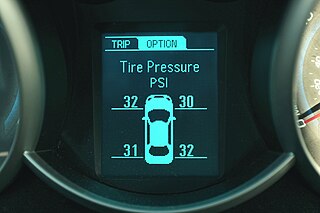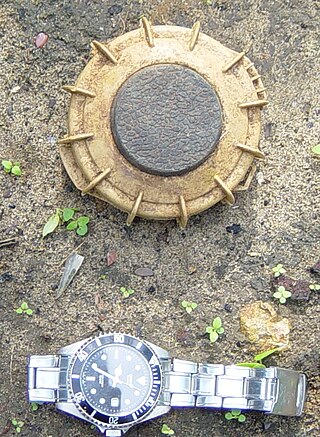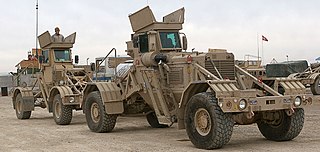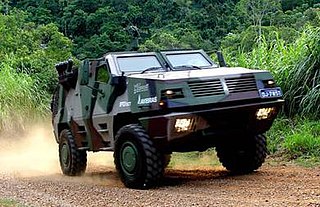
A land mine, or landmine, is an explosive weapon often concealed under or camouflaged on the ground, and designed to destroy or disable enemy targets as they pass over or near it. Land mines are divided into two types: anti-tank mines, which are designed to disable tanks or other vehicles; and anti-personnel mines, which are designed to injure or kill people.

A tire is a ring-shaped component that surrounds a wheel's rim to transfer a vehicle's load from the axle through the wheel to the ground and to provide traction on the surface over which the wheel travels. Most tires, such as those for automobiles and bicycles, are pneumatically inflated structures, providing a flexible cushion that absorbs shock as the tire rolls over rough features on the surface. Tires provide a footprint, called a contact patch, designed to match the vehicle's weight and the bearing on the surface that it rolls over by exerting a pressure that will avoid deforming the surface.

Aquaplaning or hydroplaning by the tires of a road vehicle, aircraft or other wheeled vehicle occurs when a layer of water builds between the wheels of the vehicle and the road surface, leading to a loss of traction that prevents the vehicle from responding to control inputs. If it occurs to all wheels simultaneously, the vehicle becomes, in effect, an uncontrolled sled. Aquaplaning is a different phenomenon from when water on the surface of the roadway merely acts as a lubricant. Traction is diminished on wet pavement even when aquaplaning is not occurring.

An anti-tank or AT mine is a type of land mine designed to damage or destroy vehicles including tanks and armored fighting vehicles.

Rolling resistance, sometimes called rolling friction or rolling drag, is the force resisting the motion when a body rolls on a surface. It is mainly caused by non-elastic effects; that is, not all the energy needed for deformation of the wheel, roadbed, etc., is recovered when the pressure is removed. Two forms of this are hysteresis losses, and permanent (plastic) deformation of the object or the surface. Note that the slippage between the wheel and the surface also results in energy dissipation. Although some researchers have included this term in rolling resistance, some suggest that this dissipation term should be treated separately from rolling resistance because it is due to the applied torque to the wheel and the resultant slip between the wheel and ground, which is called slip loss or slip resistance. In addition, only the so-called slip resistance involves friction, therefore the name "rolling friction" is to an extent a misnomer.

Demining or mine clearance is the process of removing land mines from an area. In military operations, the object is to rapidly clear a path through a minefield, and this is often done with devices such as mine plows and blast waves. By contrast, the goal of humanitarian demining is to remove all of the landmines to a given depth and make the land safe for human use. Specially trained dogs are also used to narrow down the search and verify that an area is cleared. Mechanical devices such as flails and excavators are sometimes used to clear mines.

A tire-pressure monitoring system (TPMS) monitors the air pressure inside the pneumatic tires on vehicles. A TPMS reports real-time tire-pressure information to the driver, using either a gauge, a pictogram display, or a simple low-pressure warning light. TPMS can be divided into two different types – direct (dTPMS) and indirect (iTPMS).

An anti-personnel mine or anti-personnel landmine (APL) is a form of mine designed for use against humans, as opposed to an anti-tank mine, which target vehicles. APLs are classified into: blast mines and fragmentation mines; the latter may or may not be a bounding mine.
A tubeless tire is a pneumatic tire that does not require a separate inner tube.

The Husky VMMD is a configurable counter-IED MRAP vehicle, developed by South African-based DCD Protected Mobility and American C-IED company Critical Solutions International. Designed for use in route clearance and de-mining operations, the Husky is equipped with technologies to help detect explosives and minimise blast damage.
Geophysical MASINT is a branch of Measurement and Signature Intelligence (MASINT) that involves phenomena transmitted through the earth and manmade structures including emitted or reflected sounds, pressure waves, vibrations, and magnetic field or ionosphere disturbances.

A bicycle tire is a tire that fits on the wheel of a bicycle or similar vehicle. These tires may also be used on tricycles, wheelchairs, and handcycles, frequently for racing. Bicycle tires provide an important source of suspension, generate the lateral forces necessary for balancing and turning, and generate the longitudinal forces necessary for propulsion and braking. Although the use of a pneumatic tire greatly reduces rolling resistance compared to the use of a rigid wheel or solid tire, the tires are still typically the second largest source, after wind resistance, of power consumption on a level road. The modern detachable pneumatic bicycle tire contributed to the popularity and eventual dominance of the safety bicycle.
Direct TPMS, or direct tire pressure monitoring systems refers to the use of a pressure sensor directly mounted on the wheels or tires of a vehicle. The pressure inside the tire is measured using a pressure transducer with the pressure information being subsequently sent to the vehicle to warn the driver of under or over inflation of a tire. The pressure information is commonly transmitted to the vehicle using radio frequency (RF) technology, though systems using mechanical, electrical or magnetic methods have been used over recent years.

The AV-VB4 RE 4×4 GUARÁ is an armoured personnel carrier manufactured and developed by the Brazilian company Avibrás and tested in Haiti. It holds a crew of four and six passengers, and weighs 7.65 tonnes. GUARÁ was developed from the chassis of the German off-road vehicle UNIMOG 4000, whose platform met some important requirements, such as the ability of high-speed roads (97 km/h) and to go over various terrains, to be transported by rotary and fixed-wing aircraft, maintaining a radius of 600 km, easy maintenance and good logistic dependence, low ground pressure, great tactical mobility and the option to be equipped with additional armor, a spacious interior and yet to have a relatively light weight of 7650 kg in standard configuration. Several versions were planned, of which the most significant were: Command Post, anti-tank equipped with missiles and radar, forward reconnaissance, mortar carrier, Ambulance, UNO etc..

The Transnet Freight Rail Class 19E of 2009 is a South African electric locomotive.

NIRA Dynamics AB is a Swedish company focusing on research and development of signal processing and control systems for the automotive industry. It supplies automotive original equipment manufacturers (OEMs) and suppliers in Europe, North America, Latin America, and Asia with its products and systems. In 2021, the number of vehicles equipped with NIRA's main product, TPI, exceeded the benchmark of 75,000,000.

The following outline is provided as an overview of and topical guide to tires:

Stemco is a Longview, Texas, based company that manufactures and distributes products for the global commercial vehicle market. Its major product categories include wheel end products, brake products, intelligent transportation systems and suspension components.

Explorer 13,, was a NASA satellite launched as part of the Explorer program on 25 August 1961, at 18:29:44 GMT, from Wallops Flight Facility (WFF), Virginia.

Explorer 23 was the last of three S-55 NASA micrometeoroid satellites launched as part of the Explorer program. Its purpose was to obtain data on the near-earth meteoroid environment, thus providing an accurate estimate of the probability of penetration in spacecraft structures by meteoroids and allowing a more confident definition of the penetration flux-material thickness relation to be derived.















